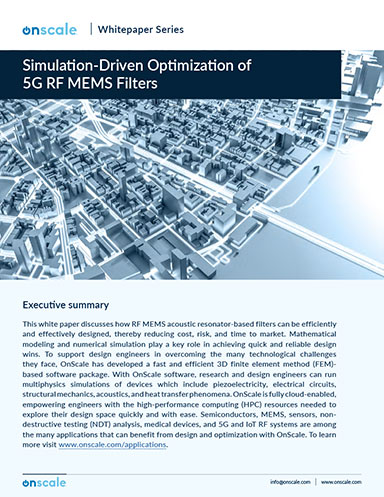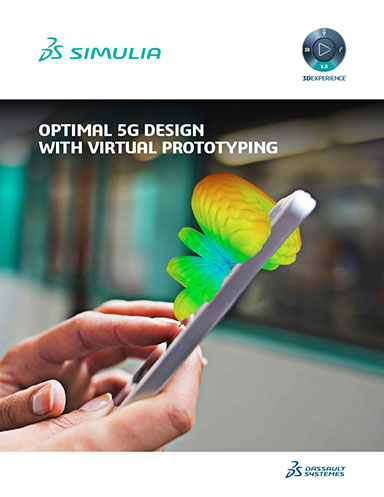
Image courtesy of Getty Images/Panuwat Sikham.
Latest News
August 1, 2019
Wireless communication is proliferating across product categories as more devices require multiple types of radios, more types of products and equipment are joining networks via the Internet of Things (IoT), and carriers build out faster 5G networks.
Current wireless standards are increasingly complex, and engineering teams that have to ensure their designs conform to those standards are struggling to keep up. Complicating things is the fact that various design domains involved in these projects (radiofrequency [RF], analog, antenna, digital, software) work in silos, lack a fundamental understanding of the requirements needed for compliance testing in other specialties and don’t have access to a shareable modeling platform.
The standards are also constantly evolving. “Staying up to date with the latest version of the standard is important so you can conform,” says Roger Nichols, 5G program manager at Keysight Technologies. “It moves pretty fast, so that can be a challenge.”
“If you want the best design, you have to stay on top of the standards, or hire somebody else who does,” adds Walt Maclay, president of Voler Systems.
The increased use of narrowband is also putting pressure on engineers working in wireless. “Everyone has this demand, and they want to communicate infinitely long distances with very small batteries,” Maclay says. “They are designing devices that have to have very low power consumption, but that have to connect directly to the internet.”
The lack of a unified workflow makes it difficult for teams to efficiently simulate, test and validate designs prior to production. Compounding this issue is the fact that designing for 5G and IoT applications requires more multiphysics modeling.
“The antenna engineers don’t know about the smart algorithms that drive the antenna, and the communications people don’t know anything about antennas,” adds Nick Buris, president of smart antenna design specialist Nebens.
The siloed approach can lead to certification test issues further along in the process. Because transmitters have to follow string standard conformance requirements, companies have to set up tests to replicate what the standards specify. Those companies have to spend a significant amount of money on test equipment that is carefully calibrated to perform the tests.
“The challenge with 5G in particular is that the number of operations and scenarios that have to be accounted for is an order of magnitude greater than LTE,” says Ken Karnofsky, senior strategist at MathWorks. “There are a higher number of tests and the number of things that can go wrong is greater.”
Additionally, wireless communications are now a part of products and systems that were previously unconnected, so the need for some level of RF expertise is a new requirement for many companies and engineers.
This shift has created an increasing interest in using simulation to identify problems and ensure conformance prior to actually building something and sending it to a test lab or the production line. If problems are found with a product during the conformance testing phase, the cost and complexity of going back and fixing the problem are substantially increased.
Next-Generation System Challenges
Although conformance with most wireless standards can present similar challenges, integrating 5G technology has exacerbated some of these existing problems while creating new issues. 5G uses scalable numerology to support different use cases and services, and this increases the complexity of testing because there are many more possible iterations that must be tested against different use case scenarios. The higher frequencies and wider bandwidths possible in the most recent 5G versions also create a wider array of potential signal impairments.
“If you want the best design, you have to stay on top of the standard, or hire someone else who does.”
5G also leverages beam steering techniques at mmWave frequencies, and 5G new radio (NR) systems need to co-exist with other commercial and military wireless networks, while mitigating against potential interference. For some devices, 5G also will result in increased signal-routing complexity and higher antenna bandwidth.
“Antenna design is paramount, especially as you need more antennas and higher frequencies,” Buris says. “The design becomes more delicate.”
Traditionally, it has been difficult to provide a comprehensive framework for simulating and testing these products because the various component operations have been siloed. The software engineers, digital system engineers, RF and analog specialists all work with different tools in different departments.
“The challenge now with 5G and other standards that are moving to higher frequencies and higher bandwidth is that parts of the system that used to be all analog are done in digital form, or might use digital algorithms to compensate for some of the nonlinear behavior of the RF system.”
Exploring which trade-offs are most effective in engineering and cost requires tools and skills that cut across those boundaries. “The engineers need tools that allow them to consider some aspects and incorporate more insight in the RF/analog part of the system to do their work and know that they are doing it correctly, more so than in the past,” Karnofsky says.
An Interdisciplinary Approach
Some tools are emerging to help companies provide a more holistic system outlook to engineers so that they can optimize the entire design—not just the individual components. MathWorks takes a simulation-to-test approach that provides a toolbox for engineers that allows them to put together a single model to help predict system performance.
“The RF engineer, for example, can give an accurate model of what they are designing to the system architect or digital designer, and they can incorporate that into their simulation as they develop their part of the system,” Karnofsky says. “They aren’t making flawed assumptions.”
Nebens offers MIMObit, a simulation tool that allows users to assess the performance of a multiple input/multiple output (MIMO) antenna system at the capacity and throughput level, as well as the dynamic range of communication algorithms with realistic antenna systems. It also helps simulate spectrum sharing, dynamic spectrum access and system coexistence.
Nebens helps make a connection between antenna design and capacity/throughput testing, according to Buris. “Right now, antenna design specifications that people adhere to are based on intermediate performance metrics, but those don’t necessarily relate to capacity and throughput,” he says. “As a result, they may pass these intermediate tests, but they don’t pass the final certification testing. In our tools, we can predict the performance at the throughput and certification test level as they are designing the antenna systems.”
At MathWorks, Karnofsky says that the company has developed simplified interfaces so that an RF or antenna engineer, for example, can reference a pared-down version of the digital details of the standard. “They don’t need all of the details, just enough details that are relevant to their challenges as an RF engineer,” Karnofsky says. “On the digital side, they get every detail on the standard. But there is also a graphical tool that simplifies that down to what an RF or antenna engineer would need to use.”
COMSOL also recently released a COMSOL Multiphysics tool so that RF designers can integrate electromagnetic simulations with heat transfer, structural mechanics, fluid flow and simulations. With this tool, designers also can model coupled physics effects as they would occur in a real-world application.
At Keysight, Nichols says that the company emphasizes having solutions that can simulate the entire system, which help reduce design issues reaching the test phase. “It’s more of an integrated approach instead of measuring particular stimulus and response approaches,” Nichols says. “We have a network emulation system that cannot just make RF measurements, but also make measurements to ensure the entire system works properly.”
Keysight has also reduced the complexity of the measurement process and engages in a lot of field training to help users get the information they need quickly.
Buris says more companies will need to shift to this multidisciplinary approach to meet these evolving wireless standards challenges. “With this methodology, you can optimize for the ultimate goal,” he says. “That gives you a product that performs better, as well as being smaller and cheaper. The RF and antenna people need to know more about communications, and vice versa. All of the algorithms on the communication side completely oversimplify the antenna systems.”
In some cases, companies outsource some element of the design work to a specialist who already has the ability to bridge those different design domains. “We get customers who have done this type of design before, or maybe they do mechanical design but not wireless,” Voler’s Maclay says. “In some cases they don’t want to hire a team and train them, or they are under deadline pressure.”
Benefits of a Shared Simulation Environment
Having engineers collaborate or access a shared framework also helps eliminate a common problem in wireless design: over-engineering. When working on assumptions, for example, designers sometimes overcompensate by taking more care than necessary to avoid interference. That adds cost to the finished product. With accurate simulation data from other departments, they can optimize the design more effectively.
“If you overdesign at the intermediate performance specification, it is impossible to get optimized performance and throughput later,” Buris says.
This approach also saves time and additional costs by identifying problems prior to the physical testing phase, when it is more expensive to fix any issues.
It also enables design optimization that can result in better products. “A good example in 5G is MIMO technology, which gives you the ability to steer and focus the signal,” Karnofsky says. “That requires code design, digital, RF and antenna technologies, and they have to be done all together to optimize across those domains. In addition to getting a cheaper, faster process, you can get a better process through simulation.”
“This is not rocket science, but it’s getting closer.”
— Roger Nichols,
Keysight Technology
Implementing this type of approach takes time and training—a difficult problem in a busy organization. “How do you get people up to speed on something new?” Karnofsky says. “You identify pilot projects and try out new methods so people can manage the learning curve on a reasonable basis.”
Buris goes further, noting that an interdisciplinary approach will require restricting the way engineers are trained from the get-go. “Start at the education system level,” Buris says. “The educational system is segmented among mechanical, RF and communications, and that segmentation permeates up to the work environment. You can’t really fix it efficiently at the company level without going to the academic level first.”
Nichols at Keysight says the company is focused on making simulation and test tools easier to access and use throughout the design process. That includes finding ways to provide visualization for the air testing of millimeter wave systems so that they can understand the results. Keysight is also trying to find ways to make these over-the-air tests more accessible to a wider range of professionals who don’t necessarily have deep RF expertise.
“This is not rocket science, but it it’s getting closer,” Nichols says. “While it’s easy to provide that understanding to an RF engineer, it’s much more difficult for someone that doesn’t have the fundamental understanding of electromagnetic physics. We have to make those things more straightforward.”
Software usability and communication will be even more important as more devices are linked to the wireless network via IoT applications. “If your device has a primary function do something other than communicate—like measure or monitor—then how do you bring in that communication piece without affecting the primary function?” Karnofsky asks. “You have to build that in a way that keeps costs down and provides a high battery life. It will get more and more pervasive as other types of engineers need to factor the communication element into their designs. They don’t need all of the details of the standard, but need to know the essence and consequences as far as it affects the overall system.”
More COMSOL Coverage
More Keysight Technologies Coverage
More MathWorks Coverage
Subscribe to our FREE magazine, FREE email newsletters or both!
Latest News
About the Author
Brian Albright is the editorial director of Digital Engineering. Contact him at [email protected].
Follow DE





